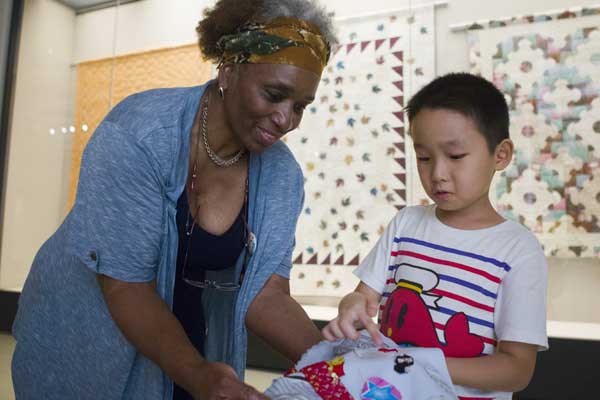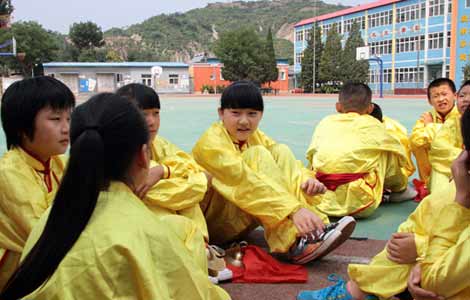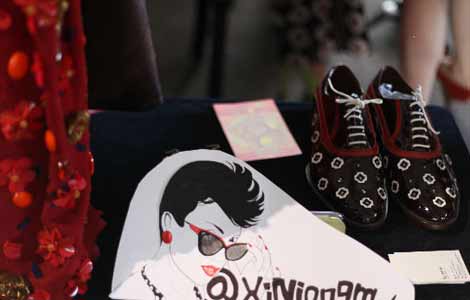A million little pieces
Updated: 2013-08-30 01:38
By Mike Peters (China Daily)
|
|||||||||||
Quilting is an art form born from pragmatic necessity, but as Mike Peters discovers, the traditional craft has come a long way from its humble origins.
Somewhere in America, a woman is cutting swathes of fabric to stitch together to tell the story of the career of a retiring military officer. She works with a pair of scissors that have been used for this purpose many times before.
Down the road, or across the country, another woman lovingly stitches a well-padded quilt that will keep a new baby, perhaps yet to be born, toasty and warm on a cold winter's night.
 |
|
Yao Zhengyuan shows his work to Edna J. Patterson-Petty, who teaches basic quilt-making to children on the sideline of the exhibition. [China Daily] |
They may be working alone, but they are joined by thousands of sister quilters linked to each other by a traditional art practiced for generations, often in their own families. Theirs is the moving spirit behind a traveling exhibition, The Sum of Many Parts: 25 Quiltmakers from 21st Century America, which opened in Beijing last week at the Chinese Museum of Women and Children.
Many of the artists got their start for the same reason quilt-making did: the arrival of winter's icy finger in bedrooms long before modern heating.
Edna J. Patterson-Petty's first exposure to quilting was as a fabric recycler. As a little girl, she had the job of cutting waistbands and ripping seams from old clothing so her mother could make new quilts for the family's beds. She didn't think of quilting as art until she was a college student. Now, the quilts she makes, such as Out of the Box, her multi-colored offering in the Beijing show, have been replicated in a glass mural at the St. Louis Lambert Airport.
Eric Wolfmeyer, the only man featured in the show, doesn't think of himself as a quilter but as "an artist who happens to work in the medium of quilts". He gave away most of his first quilts, he says, until friends and family encouraged him to try selling them. His Portmanteau is a traditional block design, Arabic lattice, that was popular in the 1930s.
The common threads that link diverse artists — from aerospace engineer Carolyn Mazloomi to Patricia Renault Stuen, a Native American of the Chippewa tribe — is a recurring theme in the quilt show that opened in Shanghai last fall for a multi-city China tour that ends this summer with the Beijing exhibition.
"America is not like a blanket — one piece of unbroken cloth, the same color, the same texture, the same size," US civil-rights leader Jesse Jackson once famously said. "America is more like a quilt — many patches, many pieces, many colors, many sizes, all woven and held together by a common thread." And while the US embassy has brought the show to China as a showcase of American culture, the organizers are quick to point out that the "common thread" runs across national borders as well as time.
Marsha MacDowell, professor of art history and the folk arts museum at Michigan State University, says quilting is an old art with a long and deep history around the world, especially in China. One Chinese quilt tradition, she says, has become popular in the US, too: the 100 Good Wishes Quilt, where members of a community each contribute a piece of fabric to make a quilted wrap for a new baby.
Noting that a well-preserved quilted fragment excavated in the Xinjiang Uygur autonomous region dates back 1,700 years, MacDowell says the touring show has been a great opportunity to bring the quilting traditions of the two countries together. A quilt researcher and scholar, MacDowell is one of the founders of The Quilt Index, a digital archive that captures traditional practices around the world.
One of the quilt show's previous stops was in Kunming, where the Yunnan Nationalities Museum has its own collection that MacDowell hopes will soon be documented online in The Quilt Index.
Professor Yang Yuan, a curator for the Chinese Museum of Women and Children, notes that emperors from the Ming (1368-1644) and Qing (1644-1911) dynasties wore quilted silk but common folk treasured the warmth, the utility and the decorative art of quilts made from any fabric at their disposal: cotton, animal hide, even cured fish skin. Like American quilts, some reflect themes and values of a whole people, while others tell stories that are deeply personal.
"I like to be surrounded by music when I work," says Patterson-Petty, who is visiting Beijing in conjunction with the show.
"Music brings out moods and colors from inside of me, and it inspires any piece I may be doing at the time."
Tapping into that creativity keeps her smiling when she teaches her art to young people, she says, and it shows that the future of quilt-making can be as exciting as its past.
Related Stories
Asia Quilt Festival 2011-08-05 11:39
Filial piety wrapped up in quilts 2011-12-20 22:45
largest quilt exhibition in NY 2011-03-28 09:32
Tibetan Quilts 2010-06-09 15:43
Today's Top News
Crime and punishment for corrupt officials
China leads the way on multilateral military co-op
US vows action in Syria even without UN backing
Putin sets goals for upcoming G20 summit
China, US discuss defense ties
5-yr work plan to fight graft unveiled
Trending news across China
Trial of Bo Xilai: Evidence, charges and defense
Hot Topics
Lunar probe , China growth forecasts, Emission rules get tougher, China seen through 'colored lens', International board,
Editor's Picks

|

|

|

|

|

|





